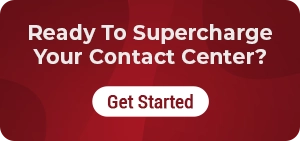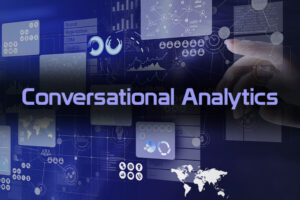While the role of call centers is crucial in customer service, companies often choose between inbound and outbound call centers. Each of these call centers come with unique functionalities, benefits, and challenges. This article explores the definitions, success KPIs, benefits, and considerations for both inbound and outbound call centers, helping you determine the best approach for your business needs. Additionally, we’ll discuss blended call centers, which combine the strengths of both inbound and outbound operations.
What is an Inbound Call Center?
An inbound call center primarily handles incoming calls from customers seeking assistance, information, or support. These contact centers are designed to provide exceptional customer service and support through various features and technologies.
How does an Inbound Call Center Work?
So how does an inbound call center work? Here are a few essential processes, tools and integrations that are needed in an inbound contact center:
Call Routing
Efficient call routing ensures that customer calls are directed to the appropriate agent or department based on the nature of their inquiry, improving response times and customer satisfaction.
Call Queue Management
Effective call queue management minimizes wait times and ensures that customers are attended to promptly, reducing frustration and enhancing the overall customer experience.
Call Recording
Call recording allows for monitoring and evaluating agent performance, ensuring quality control and compliance with company policies and regulations.
Integrations
Integrating CRM software and other tools enables agents to access customer information quickly, providing personalized and efficient service. These integrations allow call center agents to access and manage customer information swiftly, ensuring personalized and efficient service. Here are some key integration features and their benefits:
- CRM software integration provides enhanced customer profiles, streamlined workflows, and proactive support and sales opportunities. Integration with communication tools ensures a unified view of customer interactions across all channels, offering a consistent customer experience and improved efficiency.
- Helpdesk and ticketing system integration facilitates efficient issue resolution and better collaboration, while integrating a knowledge base and self-service tools empowers agents and customers with easy access to information, leading to faster resolutions and continuous improvement.
- Integrating analytics and reporting tools provides real-time insights into call center performance and customer behavior, enabling data-driven decisions, performance monitoring, and enhanced customer insights.
Integrating communication tools like email, chat, social media, and SMS with the call center platform provides a unified view of customer interactions, ensuring a consistent experience. It enhances efficiency by allowing agents to manage all communications from one interface and improves reporting and analytics, offering valuable insights into customer behavior and call center performance.
Inbound Call Center Success KPI’s
| KPI (Key Performance Indicator) | Description |
|---|---|
| Customer Satisfaction Score (CSAT) | Measures the overall satisfaction of customers with the service they receive, indicating the effectiveness of the call center. |
| Customer Dissatisfaction Score (CDS) | Identifies areas where customers are unhappy, providing insights for improvement. |
| Net Promoter Score (NPS) | Gauges customer loyalty by determining the likelihood of customers recommending the company to others. |
| First Contact Resolution Rate (FCR) | Tracks the percentage of customer issues resolved on the first call, reflecting the call center’s efficiency and competence. |
Inbound Call Center Benefits
- Customer Loyalty: Providing high-quality service fosters customer loyalty, encouraging repeat business and long-term relationships.
- Feedback: Inbound call centers serve as valuable channels for collecting customer feedback, which can be used to improve products, services, and processes.
- Operational Efficiency: Streamlined processes and quick resolution of customer issues lead to increased operational efficiency, reducing costs and improving service levels.
- Real-Time Customer Support: Immediate assistance provided through inbound calls enhances customer satisfaction and trust in the company.
- Enhanced Employee Productivity: Structured and well-integrated call centers improve agent productivity by providing the necessary tools and information to handle customer inquiries effectively.
- Data Collection and Analysis: Inbound call centers collect valuable data on customer preferences and behaviors, aiding in market research and strategic planning.
“Call center KPIs are the compass that guides your customer service strategy, revealing not just where you stand but also where you need to go to achieve excellence in customer satisfaction and operational efficiency.” – Christian Montes Executive VP of Client Operations, NobelBiz
What Are Outbound Call Centers?
An outbound call center focuses on making outgoing calls to customers and prospects for various purposes, including sales, marketing, and customer outreach. These centers are essential for proactive customer engagement and lead generation.
How does an Outbound Call Center Work?
An outbound call center works by proactively contacting potential or existing customers on behalf of a business. The primary functions and processes involved in an outbound call center include:
Campaign Planning: Businesses plan campaigns with specific goals, such as sales, lead generation, customer surveys, or appointment setting. They define the target audience and objectives for each campaign.
List Generation: A list of contacts is generated based on the target audience. This list can be sourced from customer databases, purchased lists, or leads collected through marketing efforts.
Call Scripting: Agents are provided with scripts to guide their conversations. These scripts include key information about the product or service, talking points, and responses to common objections.
Dialing Methods: Outbound call centers use different dialing methods, such as manual dialing, automatic dialing, or predictive dialing. Predictive dialing is the most efficient, as it automatically dials multiple numbers and connects agents only when a call is answered.
Agent Training: Agents receive training on the campaign goals, product or service details, and effective communication techniques to handle calls professionally and persuasively.
Call Execution: Agents make calls to the contacts on the list, following the script and adapting to the conversation as needed. They aim to achieve the campaign goals, whether it’s making a sale, generating a lead, or gathering information.
Data Entry and CRM Integration: Agents enter call outcomes and relevant customer information into a CRM (Customer Relationship Management) system. This helps in tracking progress, managing follow-ups, and updating customer records.
Performance Monitoring: Managers monitor key performance indicators (KPIs) such as call success rate, lead conversion rate, average handle time, and cost per acquisition to evaluate the effectiveness of the campaign and individual agent performance.
Reporting and Analysis: Data from the campaign is analyzed to assess its success, identify areas for improvement, and make data-driven decisions for future campaigns.
Compliance: Outbound call centers adhere to regulations and guidelines, such as the Do Not Call (DNC) registry, to ensure ethical and legal calling practices.
Outbound Call Center Success KPI’s
| KPI (Key Performance Indicator) | Description |
|---|---|
| Answer Success Rate | Measures the percentage of calls answered by customers, indicating the effectiveness of contact strategies. |
| Lead Conversion Rate | Tracks the percentage of leads converted into customers, reflecting the success of sales efforts. |
| Average Handle Time (AHT) | Monitors the average time spent on each call, helping to optimize efficiency and productivity. |
| Cost per Call | Calculates the cost associated with making each call, essential for budgeting and cost management. |
| Cost per Acquisition (CPA) | Determines the cost of acquiring a new customer through outbound efforts, providing insights into the return on investment. |
Outbound Call Center Benefits
Outbound call centers offer numerous advantages that can drive business growth and success. They are instrumental in boosting lead generation and sales through proactive outreach, helping companies expand their customer base. Regular customer engagement through outbound calls also increases brand awareness, enhancing visibility and market presence. Moreover, outbound call centers are valuable for conducting market research, providing insights that aid in strategic decision-making. Understanding the differences between contact centers and call centers can further help businesses choose the most suitable platform to meet their specific needs.
Here are some benefits of having an outbound contact center:
- Boosts Lead Generation and Sales: Outbound call centers are instrumental in generating leads and driving sales through proactive outreach.
- Increases Brand Awareness: Regular customer engagement increases brand visibility and awareness, helping to build a strong market presence.
- Helps Conduct Market Research: Outbound calls can be used to gather valuable market insights, aiding in strategic decision-making.
Brayan Carpio
Choosing The Right Call Center For Your Business
Selecting the right call center for your business involves a strategic evaluation of several key factors. Here are expanded considerations for making an informed decision:
Consider Your Business Goals
Align call center choice with objectives like customer support, sales, or market research.
- Customer Support: Inbound call centers handle inquiries, resolve issues, and provide technical support.
- Sales and Marketing: Outbound call centers focus on telemarketing, sales calls, and lead generation.
- Market Research: Outbound call centers conduct surveys and research to gather customer insights.
Analyze Your Customer Base
- Communication Preferences: Choose a call center offering preferred communication channels (phone, email, chat, social media).
- Customer Demographics: Tailor services to customer demographics for better satisfaction and engagement.
- Volume and Type of Interactions: Match call center capabilities to interaction volume and complexity (inbound for high call volumes and complex inquiries, outbound for sales and follow-up).
Evaluate Resources
- Budget: Balance setup and maintenance costs with potential ROI.
- Technology: Ensure technology infrastructure supports the chosen call center type, including software, CRM integration, and communication tools.
- Personnel: Match staffing needs with required expertise (e.g., agents skilled in multiple channels for contact centers, strong sales skills for outbound centers).
Blended Call Centers
A blended call center combines inbound and outbound operations, offering a comprehensive solution for businesses seeking to optimize customer service and sales efforts.
“Blended call centers offer the perfect synergy of inbound and outbound capabilities, driving operational efficiency while delivering seamless and personalized customer experiences across all touchpoints.” –– Christian Montes, Executive Vice President of Client Operations @NobelBiz
Benefits of Blended Call Centers
Blended call centers, which combine inbound and outbound call capabilities, offer several significant benefits that can enhance operational efficiency and customer satisfaction:
Increased Efficiency: Blended call centers maximize agent productivity by allowing them to handle both incoming and outgoing calls, reducing idle time and optimizing workforce utilization. Agents can switch to outbound tasks during low inbound call periods, ensuring resources are used effectively.
Improved Customer Satisfaction: Blended call centers enhance customer experience by providing seamless service across touchpoints. Agents access comprehensive customer information, enabling personalized and consistent support, which builds stronger customer relationships and increases satisfaction levels.
Capturing Sales and Leads Easier: Blended call centers improve lead generation and sales processes by allowing agents to transition smoothly from support to sales activities. This flexibility ensures proactive outreach and higher conversion rates, maintaining constant communication with customers and prospects.
Added Flexibility: Blended call centers offer the flexibility to switch between inbound and outbound tasks, adapting to fluctuating call volumes and business demands. This adaptability ensures effective response to different scenarios, maintaining high performance and customer satisfaction.

Challenges When Choosing a Blended Call Center
While blended call centers offer numerous benefits, there are also challenges that businesses must address to ensure successful implementation and operation:
Training: Ensuring agents are well-trained for both inbound and outbound calls is essential, requiring comprehensive programs that cover customer service techniques, sales strategies, and call center technology. Ongoing training is necessary to keep agents updated with best practices and evolving customer expectations.
Technology: Investing in robust technology that integrates with CRM systems, communication tools, and analytics platforms is crucial for efficiency. This technology must enable smooth transitions between tasks and support omnichannel communication, though implementing it can be costly and complex.
Call Patterns: Managing varying call patterns and volumes requires careful planning and resource allocation. Blended call centers need effective workforce management strategies, such as predictive analytics and flexible scheduling, to handle fluctuations and ensure consistent service levels.
NobelBiz’s Blended Call Center Platform – Omni+
The NobelBiz’s Omni+ platform is an all-in-one cloud-based omnichannel contact center solution that enhances efficiency, customer satisfaction, and sales performance. It integrates advanced features and technologies, allowing businesses to manage inbound and outbound calls seamlessly from a single interface. With Omni+, agents can handle voice calls, SMS, email, and social media interactions like WhatsApp, Facebook Messenger, Twitter, and Telegram, ensuring a consistent and personalized customer experience.
Omni+ simplifies agent workflows and offers valuable insights into customer behavior, helping businesses anticipate and meet customer needs. The platform’s scalability and automation capabilities enable quick adaptation to changing demands and reduce operational costs. By unifying communication channels and providing a seamless experience, NobelBiz’s Omni+ ensures improved agent productivity and enhanced customer engagement, making it an ideal choice for modern contact centers.

Michael McGuire is a contact center industry expert with almost two decades of experience in the space. His experience includes roles as Director of Contact Center Digital Transformation at NobelBiz, and as Director of Operations at FLS Connect, managing multiple call centers. As President of Anomaly Squared and Targeted Metrics, Michael successfully transitioned companies into remote operations and significantly boosted revenues. With a strong background in customer service, leadership, strategic planning, and operations management, Michael excels in driving growth and innovation in the call center space.
Mike is also a proud Board Member for R.E.A.C.H Trade Group, promoting consumer protection and satisfaction and Co-host of the Off Skripted Podcast – a show about Life, Call Centers and everything in between.




 “Call center KPIs are the compass that guides your customer service strategy, revealing not just where you stand but also where you need to go to achieve excellence in customer satisfaction and operational efficiency.” – Christian Montes Executive VP of Client Operations, NobelBiz
“Call center KPIs are the compass that guides your customer service strategy, revealing not just where you stand but also where you need to go to achieve excellence in customer satisfaction and operational efficiency.” – Christian Montes Executive VP of Client Operations, NobelBiz “Blended call centers offer the perfect synergy of inbound and outbound capabilities, driving operational efficiency while delivering seamless and personalized customer experiences across all touchpoints.” –– Christian Montes, Executive Vice President of Client Operations @NobelBiz
“Blended call centers offer the perfect synergy of inbound and outbound capabilities, driving operational efficiency while delivering seamless and personalized customer experiences across all touchpoints.” –– Christian Montes, Executive Vice President of Client Operations @NobelBiz



